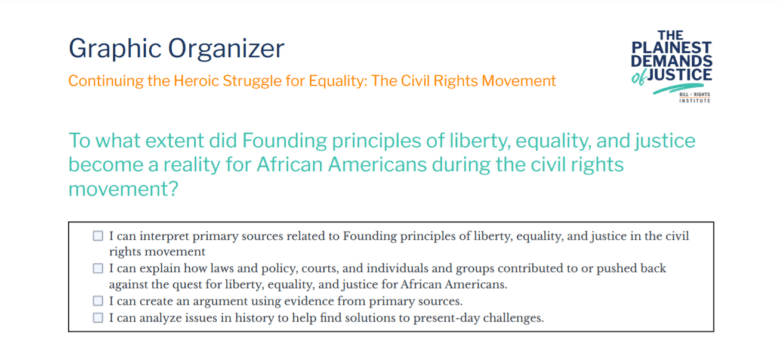Graphic Organizer: The Civil Rights Movement
To what extent did Founding principles of liberty, equality, and justice become a reality for African Americans during the civil rights movement?
- I can interpret primary sources related to Founding principles of liberty, equality, and justice in the civil rights movement.
- I can explain how laws and policy, courts, and individuals and groups contributed to or pushed back against the quest for liberty, equality, and justice for African Americans.
- I can create an argument using evidence from primary sources.
- I can analyze issues in history to help find solutions to present-day challenges.
Directions: Identify the main ideas and connections to the Founding principles using the information you gathered from your assigned documents.
| Document Title and Date | Main ideas | Connection to Founding Principles |
|---|---|---|
| Richard Wright, Black Boy, 1945 | ||
| Sweatt v. Painter, 1950 | ||
| Ralph Ellison, Invisible Man, 1952 | ||
| Brown v. Board of Education, 1954 | ||
| Martin Luther King, Jr., “The Montgomery Improvement Association Mass Meeting at Holt Street Baptist Church” Speech, 1955 | ||
| The Southern Manifesto, 1956 | ||
| Student Nonviolent Coordinating Committee Founding Statement, 1960 | ||
| James Baldwin “Fifth Avenue, Uptown,” 1960 | ||
| Freedom Rides Photographs, 1961 | ||
| Martin Luther King, Jr., “Letter from Birmingham Jail,” 1963 | ||
| Martin Luther King, Jr., “I Have a Dream”, 1963 | ||
| John Lewis, Speech at the March on Washington, August 28, 1963 | ||
| “We Shall Overcome” | ||
| Malcolm X, “Message to the Grassroots”, 1963 | ||
| Civil Rights Act, 1964 | ||
| Fannie Lou Hamer Testimony before the Credentials Committee, Democratic National Convention, August 22, 1964 | ||
| Images of Bloody Sunday, 1965 | ||
| Voting Rights Act, 1965 | ||
| Loving v. Virginia, 1967 |
